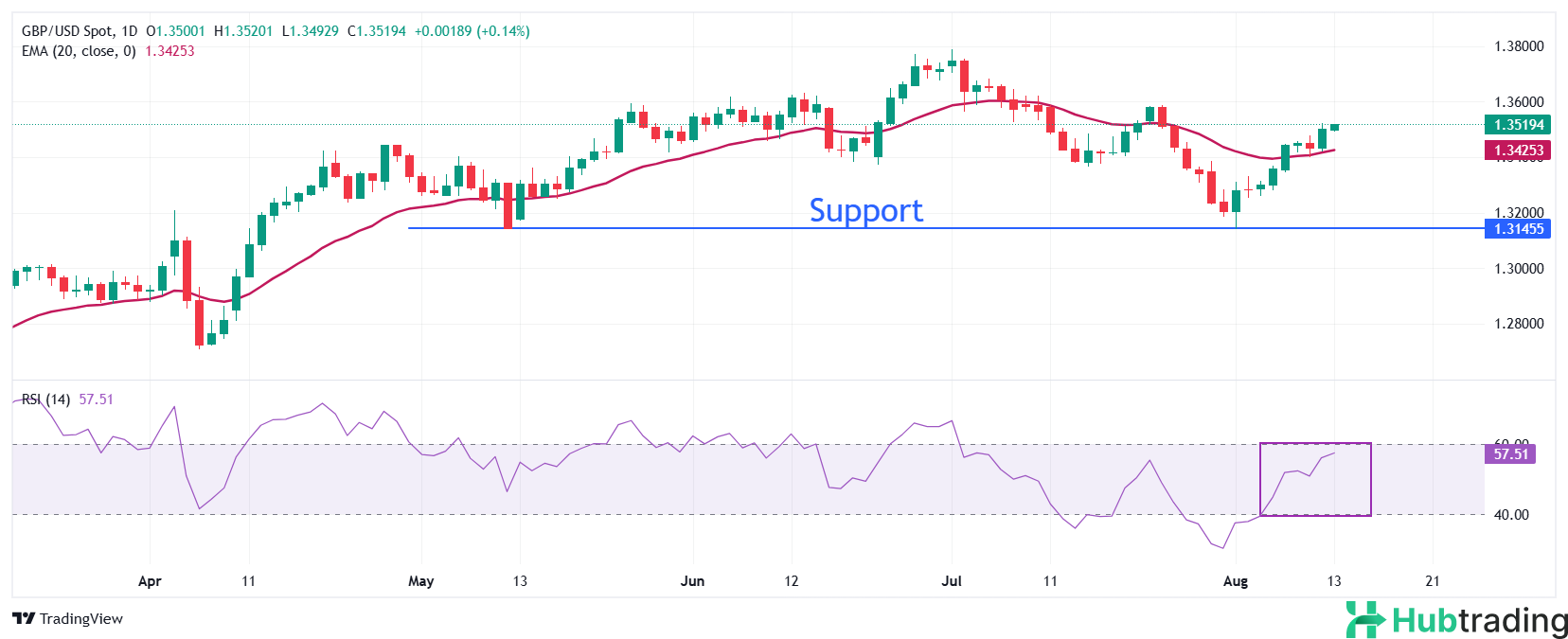-
The Pound Sterling strengthens across the board as investors look ahead to the UK’s Q2 GDP release on Thursday.
-
Hiring activity in the UK remains subdued as businesses respond to higher employer social security contributions.
-
Fresh US inflation data prompts traders to increase bets on a Federal Reserve rate cut at the September meeting.
The Pound Sterling (GBP) outperforms its major peers on Wednesday as investors turn their focus to the preliminary UK Q2 Gross Domestic Product (GDP) data, set for release on Thursday.
Economists forecast a modest 0.1% quarterly growth in Q2, a sharp slowdown from the 0.7% expansion recorded in the previous quarter. On an annual basis, the economy is expected to grow by 1%, falling short of the Bank of England’s (BoE) 1.25% projection made during last week’s policy meeting. In comparison, the economy expanded by 1.3% in Q1.
A further slowdown in GDP growth would intensify pressure on BoE policymakers, who are already grappling with persistent inflationary concerns. Notably, the central bank recently revised its one-year forward Consumer Price Index (CPI) forecast upward to 2.7% from 2.4%.
At the same time, softening labor market conditions are adding to the BoE’s challenges, partly driven by higher employer contributions to social security. The latest data showed UK job vacancies dropped by 44,000 to 718,000 between May and July, while early estimates revealed a monthly decline of 8,000 in payrolled employees for July.
According to the Office for National Statistics, responses from the vacancy survey indicated that some businesses are choosing not to hire new staff or replace departing employees, reflecting growing caution in the labor market.
Daily Market Movers: Pound Sterling Gains Ground as Fed Rate Cut Bets Rise
- The Pound Sterling climbed to around 1.3565 against the US Dollar (USD) during Wednesday’s European trading session, extending its recent gains as the Greenback weakened under mounting pressure. The GBP/USD pair continues to benefit from increasing speculation that the Federal Reserve (Fed) will begin cutting interest rates at its September policy meeting.
- At the time of writing, the US Dollar Index (DXY), which tracks the USD against a basket of six major currencies, has fallen to around 97.70 — its lowest level in two weeks. This decline reflects a sharp shift in market sentiment following the latest US inflation data.
- According to the CME FedWatch Tool, the probability of a September rate cut has surged to 94%, up from 86% at the start of the week. This shift comes after the latest Consumer Price Index (CPI) report showed headline inflation rising 2.7% year-over-year in July, just below the 2.8% forecast, while core inflation — which excludes food and energy — accelerated to 3.1%, above both the previous reading of 2.9% and expectations of 3.0%.
- Despite the uptick in core CPI, markets focused on the lack of significant inflationary pressure from recent tariffs, reinforcing expectations for policy easing. However, not all analysts are convinced. Some caution that another rate decision hinges on upcoming employment and inflation data before the Fed’s September meeting. “As the last payrolls report demonstrated, one data release can swing the policy debate significantly,” analysts at the Commonwealth Bank of Australia noted. “We need to see the remaining data before making a strong call on a rate cut versus a hold.”
- Investors will closely watch comments from key Fed officials on Wednesday, including Richmond Fed President Thomas Barkin, Atlanta Fed President Raphael Bostic, and Chicago Fed President Austan Goolsbee, for fresh insights into the central bank’s policy stance.
Technical Outlook: GBP/USD Eyes Break Above 1.3600

The Pound Sterling continues to trend higher against the US Dollar, reaching near 1.3570 in Wednesday’s session. The short-term outlook remains bullish, supported by the pair holding above the 20-day Exponential Moving Average (EMA), currently around 1.3425.
Momentum indicators also point to further gains. The 14-day Relative Strength Index (RSI) is nearing the 60.00 mark, and a break above this level could signal renewed bullish momentum.
On the downside, key support lies at the August 1 low of 1.3140. To the upside, the next major resistance is the July 1 high near 1.3790, which could cap further gains if buyers lose momentum.





